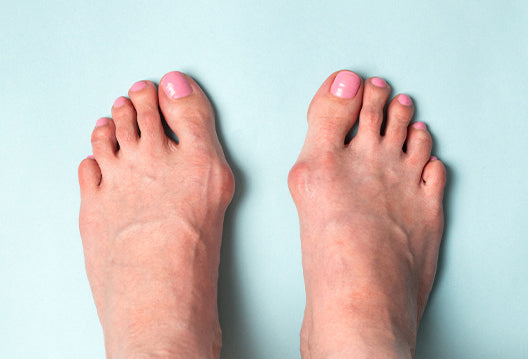What is a Bunion?
A bunion is hard to ignore. This bony prominence at the base of the big toe mars the otherwise straight line of the inner foot. Bunions occur when the first metatarsal shifts outwards towards the opposite foot, and the big toe moves inwards towards the second toe. The joint connecting the first metatarsal to the big toe bone becomes misaligned and forms a bulging bump: a bunion.
Once a bunion starts to form, the small fluid-filled pads (bursae) around the big toe joint can become inflamed, causing swelling, redness and severe pain. The medical name for a bunion is Hallux Valgus.
Our pictorial severity scale below highlights the mild to more extreme bunion (hallux valgus) conditions.
Bunion Severity
Bunions can differ in size and severity. Our pictorial scale for bunion severity highlights the mild to more extreme bunion conditions. All of these photos are taken by happy Sole Bliss customers who fit comfortably into Sole Bliss shoes.
How do Bunions Form?
People often ask "How do bunions form?" or "What causes bunions?" There are several causes of bunions:
1. Genetics
2. Biomechanics
3. Pregnancy
4. Chronic Obesity
5. Medical Conditions
6. Poorly-Fitting Footwear
1. Genetics - Most podiatrists will agree that the main cause of bunions is genetics. Your bunion could be an inherited structural foot defect. Genetics bestow us with certain foot bone shapes, and this is the most prevalent cause of bunion formation in sufferers. Blame your grandparents!
2. Biomechanics - Faults with your feet’s biomechanics, such as over-pronation or flexible joints, can cause bunions. When the body overloads the bones in your feet, the normal distribution of weight through the first metatarsal into the big toe is disrupted. This puts stress on the joint and in some cases leads to bunion formation. In Sole Bliss closed-back shoes, a small memory foam pillow (known as the superior arch support) keeps your feet in the right position and protects against this inward rolling of the foot.
3. Pregnancy - Pregnancy can lead to new arrivals – and we don’t just mean babies! The hormone Relaxin is responsible for loosening up the ligaments of the pelvic bones during childbirth. In some cases, Relaxin also affects the ligaments around the bones in your feet. When your ligaments become looser, there is a greater tendency for your bones to move away from their original position, which can lead to the formation of a bunion or the widening of the foot.
4. Chronic Obesity - Just like during pregnancy, obesity adds exaggerated stress to the structure of your feet due to the additional weight of the body, and often results in pronation (the inward rolling of the foot). This is another cause of bunions.
5. Medical Conditions - Some conditions associated with loose ligaments and joints might increase the chance of developing bunions. Some examples of medical conditions which cause bunions are Marfan Syndrome, Rheumatoid Arthritis and Psoriatic Arthritis. All Sole Bliss shoes are designed with a deep and wide toe-box which accommodates feet affected by these conditions, as well as obesity and pregnancy.
6. Poorly-fitting Footwear - High heels are commonly credited as the biggest reason for bunion formation, but this is not necessarily true. A bunion is something a person generally has a disposition to. However, if you wear poorly-fitting footwear, you may be exacerbating this pre-disposition or existing problem. Shoes which are too tight or too narrow or too pointed can worsen bunions. This progression of the severity of your bunion can be avoided by investing in footwear with sufficient width and depth in the toe box, protection for bunions and the support your feet need.
Risk Factors - Can Bunions Get Worse?
Bunions can worsen over time and become painful if you don’t look after your feet. Years of wearing poorly-fitting footwear can take its toll on your feet and exacerbate the conditions which cause bunions. However, there are things you can do to slow the progression of bunions. This includes wearing comfortable shoes for bunions!
Can Shoes Help Bunions?
By wearing the right shoes for bunions (hallux valgus), you can put a stop to the pain caused by putting pressure on your bunions. Your shoes for bunions should have a deep and wide toe-box with space for toes and tender joints. There should be no squeezing or pressing on any part of your foot. Stiff materials can be very painful for bunions so you should look for shoes made from very soft materials such as fine leather and suede.
Wearing shoes that rub or irritate your bunions can worsen them and cause other foot problems, such as blisters, corns and calluses. To discover the magic of Sole Bliss’ wide width, comfortable shoes for bunions, read all about How Our Shoes Work.
Treatment for Bunions
There are many ways to look after your bunions. Simple treatments include soaking your feet in a footbath, icing your feet or gently exercising your feet and toes.
Wearing the correct footwear for bunions is very important and contributes to your overall foot health. Follow this link to read more about Treating Bunions without Surgery.
Shoes to Help Other Foot Problems
Every Sole Bliss style can accommodate wide feet and bunions, but did you know that they can also relieve the discomfort caused by other foot problems?
Hammer Toes
If you suffer with hammer toes, you’ll know that instead of the toe laying flat in alignment with the foot, the bone connecting the toe to the foot bends upwards, with the second toe bone tilting downward to form an inverted 'V'. Poorly-fitting shoes will exacerbate the problem. Sole Bliss shoes are not only designed to provide extra width, but all of the styles are also very deep at the front to avoid putting pressure on hammer toes. For those with hammer toes, check out our Wide Fit styles which offer extra space.
Read our Blog on finding the Best Shoes for Hammer Toes here. You can also view our Collection of Shoes for Hammer Toes here.
"I have suffered with not only bunions, but irritating hammer toes for several years now, and I felt that stylish shoes were out my reach - until I found Sole Bliss! The extra wide styles are deep enough for my hammer toes, wide enough for my bunions, but secure enough at the back to keep my feet in place. THANK YOU!!!" - Andrea
Plantar Fasciitis
Affecting up to one in ten of us at some point in our lifetime, plantar fasciitis is the most common cause of pain in the heel. There is a thick fibrous band of tissue that runs from the heel to the toes called the plantar fascia, and plantar fasciitis is the inflammation of this tissue. It is most common between the ages of 40 and 60, and is often triggered by activities that put stress on the heel - such as running or long periods of standing on hard surfaces. Being overweight can also be a factor. Sole Bliss shoes provide three distinct layers of underfoot memory foam, each with different properties. The base layer is for shock absorbency, the middle layer contours around the shape of your foot and the top layer offers cushioning under the entirety of your foot. Plantar fasciitis sufferers will benefit from this luxurious underfoot support and cushioning.
Read more about what makes our shoes so comfortable for plantar fasciitis. You can also view our Collection of Shoes for Plantar Fasciitis here.
"Plantar fasciitis makes walking in any shoe painful - but high heels were the most painful of all! The cushioning in my Sole Bliss heels is unbelievable and has allowed me to feel feminine again. I'm replacing every pair I own with Sole Bliss now! Thank you" - Claire
Arthritic Joints
Painful, stiff arthritic joints can make wearing stylish shoes impossible, but no longer! The combination of the components that comprise Sole Bliss’ award-winning technology can alleviate the discomfort of arthritis in the foot. The triple-layer, custom-cushioning system alleviates pain and provides support, and the wide and deep toe box ensures arthritic joints aren’t constrained or pressurised by the shoe’s upper. Our Wide Fit shoes typically have the most accommodating fronts, making them the best shoes for arthritis sufferers.
Read our Blog on finding the Best Shoes for Arthritis here.
"The extra wide Sole Bliss styles provide enough space for my stiff, Arthritic toe joint to relax and not feel pressured by the upper of the shoe" - it's a miracle!! - Angela
Morton’s Neuroma
Ever feel like you have a pebble under the ball of your foot? Then you may be suffering from a Morton’s Neuroma. This condition occurs when nerves in the foot become inflamed or damaged, and it can make wearing any type of shoe uncomfortable. Sole Bliss styles are among the best shoes for Morton’s Neuroma, due to the three-layer custom-cushioning system underfoot that provides ultimate cushioning for troubled feet. Additionally, in all closed-back Sole Bliss heels, the anti-pronation device provides Morton’s Neuroma arch support to alleviate discomfort.
Read our Blog on finding the Best Shoes for Morton's Neuroma here. You can also view our Collection of Shoes for Morton's Neuroma here.
“I am thrilled to be able to wear heels again comfortably without my insoles after more than 10 years. Apart from bunions I also suffer from Morton's Neuroma. I am amazed how well my 2 pairs of Ingrid shoes fit me. A pair of boots are now on the agenda!! Thank you Sole Bliss!!" – Mette
Flat Feet & Over-Pronation
If you have flat feet, it is very likely that you over-pronate (roll inwards) as you walk. Your feet are flatter to the ground because your arches have dropped or collapsed. Women with flat feet are less able to absorb shock, which means the impact is being absorbed further up your legs. Sole Bliss shoes for flat feet are designed to provide ultimate cushioning and support, including shock absorption. All our closed-back shoes for flat feet contain an anti-pronation device which is a small memory foam pillow that counters over-pronation and holds your foot in the correct position.
Read our Blog on finding the Best Shoes for Flat Feet here. You can also view our Collection of Shoes for Flat Feet here.
“These shoes are a game-changer! I don't have bunions but I do have flat feet and fallen arches. For the first time I can wear my dressy shoes for hours on end without the pain or discomfort that usually comes with heels!" – Sally
Diabetic Neuropathy
Diabetic neuropathy is a unique type of nerve damage in your legs or feet. Diabetics with this type of nerve damage must pay special attention to their feet, checking them regularly and avoiding any kind of laceration injury. Sole Bliss shoes for diabetic feet provide triple-layer cushioning and support, are handcrafted from ultra-soft leathers, and are seam-free to prevent irritating the skin.
Read our Blog on finding the Best Shoes for Diabetes here. You can also view our Collection of Shoes for Diabetes here.
“Love my new Sole Bliss shoes! I suffer with diabetic neuropathy and have to be very careful with my choice of footwear. I honestly thought my days of wearing ‘normal’ footwear were over but these shoes are a revelation! So stylish and comfortable for my poor feet!" – Dawn








